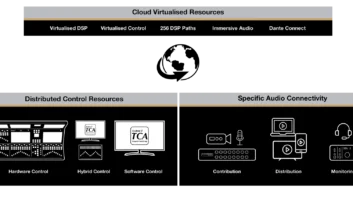From Amazon Prime Video’s coverage of the Premier League to the launch of NFL+, we’re seeing a surge towards direct-to-consumer across the sports landscape. On top of this, the fast adoption of remote work and virtual production plus the fragmentation of rights markets and supply chains has shifted the pace of change across the industry into an entirely new gear.
What’s more, consumer expectations have completely evolved. Think about how you watch TV. Is it on your iPad or smartphone? For many, it’s probably several screens at once, with our attention spread across different broadcast and online channels. All of this means the pressure is on for broadcasters to ensure they reach their audiences in the right and most cost-effective way.
At the heart of this is the fundamental need for media connectivity and processing solutions that can adapt to changing needs at the flick of a button. Now more than ever they need to be able to move fast in terms of implementation and the application of content access rights permissions. And all of this has to be done without incurring a huge cost burden.
Here, the answer lies in a cloud-based interchange.
Allowing for agile content delivery
How we consume sport is in a constant state of flux. From catching up on the cricket on BBC iPlayer from the comfort of your own sofa, to trailing Twitter for football highlights – our television habits are diversifying. And all of this is spelling out change for those delivering content.
Clearly, consumers are being more selective with what they want to pay for – triggering uncertainty in the SVoD space and giving rise to AVoD opportunities on a more accelerated basis.
On the linear broadcast side, consolidations such as Warner Media, Discovery and BT Sport is signalling a recognition among linear players that they can no longer ignore the DTC trend. No doubt this is also being driven by the spike in streaming services now on the hunt for sports rights. Only recently, Amazon and Netflix were considering bids for Formula One’s US TV rights.
As industry players update their approaches to content delivery, they must look to the cloud to simplify their workflows and leverage the flexibility it offers to avoid financial risks. The answer? A cloud-native interchange such as Arqade. This allows broadcasters to trial new services and break markets without the burden of building a physical infrastructure. In fact, we recently helped a leading international sports broadcaster trial the delivery of matches from a premium European football league in one of their Latin American territories. Arqade successfully delivered those feeds without huge initial up-front costs. Now we’re looking at how we can support that broadcaster in future.
What’s more for broadcasters considering a moving towards business models based on free-to-air advertising revenue, a cloud-based interchange would allow them to test whether this will work without having to negotiate a big carriage deal that would justify the cost of delivery.
Drive towards diversifying content
Just as the way content is being delivered is changing, so too is the content itself. Consumers are increasingly seeking additional feeds of interviews, viral social media content and simulcast feeds of celebrity commentary.
Content providers have to step up now or lose eyeballs. Of course, maximising the opportunities while minimising the complexities is no easy task. Sports media organisations must be willing to try new things and explore new avenues. But at the same time, the vital live content supply chains need to remain both reliable to support mass reach broadcast, and flexible enough to support experimentation and innovation.
When the value of a new product isn’t yet understood, this has to happen without replicating workflows and sending costs sky rocketing. Currently many distributors are publishing near-live sporting highlights to social media and creating separate workflows to integrate with the cloud-based systems which are well positioned to support this workload.
Instead, a cloud-based interchange views the entire ecosystem as a collection of connected, IP and cloud-enabled platforms while approaching the integration of them in a consistent, yet flexible way. Here, different functions can work in parallel and serialised workflows are a thing of the past.
Rather than broadcasting a world feed globally and each licensee individually downlinking, localising and re-broadcasting their version, a cloud-based ecosystem of providers and technologies allows sports organisations to more cost effectively introduce diverse content.
Securing the future of sports broadcast
Finally, while sports broadcast services should be rich in content and viewing options, they must also be secure. Only last year two big broadcasters were hit by cyber-attacks: Nine Network in Australia and Cox Media Group in the United States.
When a broadcaster is hit by a ransomware attack it can cause all kinds of disruption – internal computer systems are shut down, streaming services are stunted, and live sports events interrupted. After the infamous Sony malware attack in 2014, many sports broadcasters were forced to think about the impact a similar attack could have in the sporting world.
Fortunately, security is at the heart of cloud-based interchanges, and ones like Arqade encrypt content in transport and put the control of signal access entitlements in the hands of the rights holder.
Navigating the new ecosystem through the cloud
Sports broadcasters must explore new opportunities to diversify their portfolios and integrate their workflows, allowing them to trial new services, break new markets and increase audiences.
And as rightsholders and broadcasters are faced with a more complex ecosystem to manage than ever before, a cloud-based interchange presents an opportunity for the sports industry to come out on top of this disruptive media diversification.







